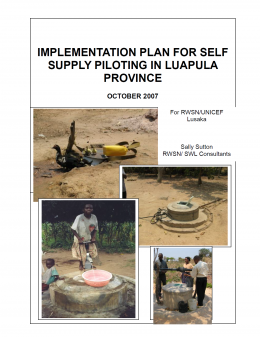RWSN Library

Author
Sutton, S.
Year of Publishing
2007
Publisher
RWSN
Institution
SWL Consultants / UNICEF
Implementation Plan For Self Supply Piloting In Luapula Province
Description:
Zambia, despite a total rural population of almost 8 million, has a low density rural population in many areas (around 14/km2) whose dispersed nature makes it difficult to serve sufficient people for handpump sustainability. At the same time much of the North of the country has plentiful groundwater reserves at shallow depth, allowing easy well construction. As a result, country-wide over 40% of protected supplies are lined shallow wells and only 13% are boreholes. Some 30% of handpumps 40% of households, (more in North-western, Western, Northern and Luapula Provinces) have dug their own (unlined) wells and increasing numbers are doing so every year. The ease of making such alternative supplies, and the low coverage by conventional communal supplies means that many are much nearer to a traditional source than a protected one, and even in communities which are theoretically ‘covered’ preference for the convenience, taste of water from traditional sources may lead to their continued use .
RWSN commissioned a study in 2006 to re-assess the situation for implementing self-supply in Zambia and this also helped to re-kindle interest. This report is the next step in response to a request from UNICEF and RWSSU, proposing an implementation plan, particularly for Luapula, but also drawing attention to the potential in Northern and Western provinces.
Bibliographical Information:
Sutton, S. (2007) Implementation Plan For Self Supply Piloting In Luapula Province. , SWL Consultants / UNICEF , RWSN
DOWNLOADS (28)
Implementation Plan For Self Supply Piloting In Luapula Province
 Google Übersetzer
Google Übersetzer
